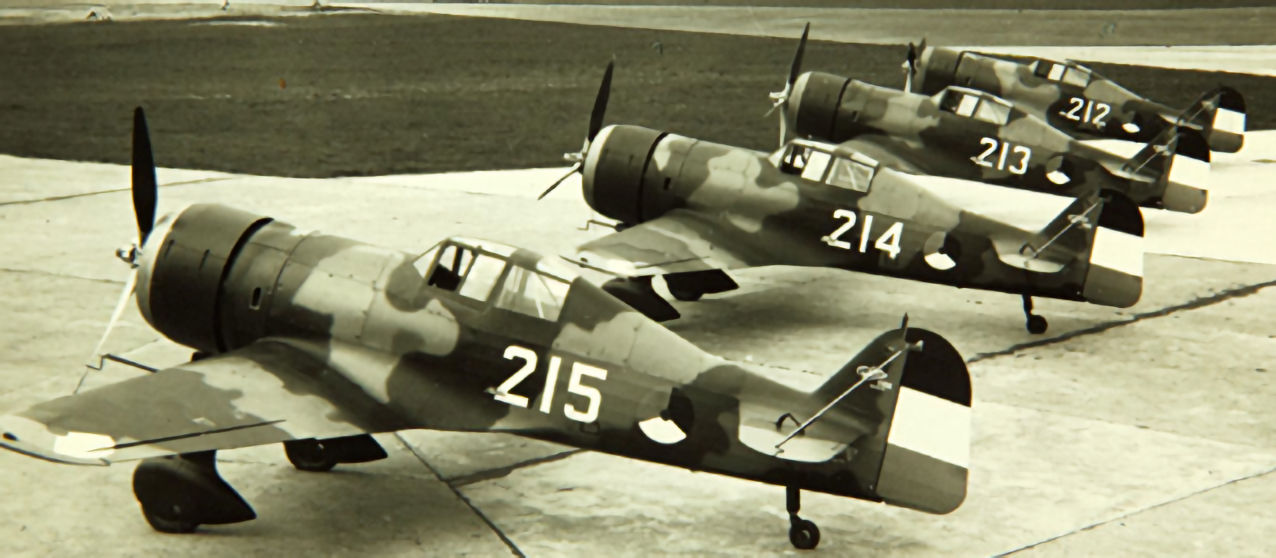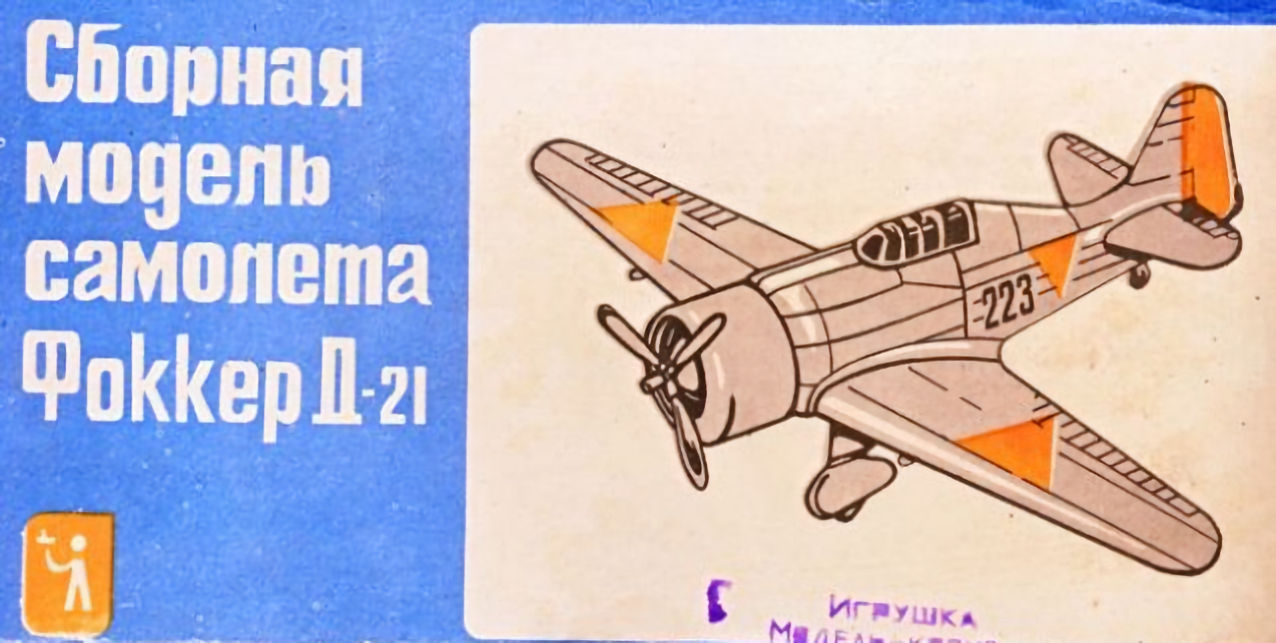Also-Ran Fighter Department
The Fokker D.XXI was a small single engine fighter designed in 1935 by Jewish German refugee, Dr Ir. Schatzki. The original requirement was for a fighter to serve in the Royal Netherlands East Indies Army. The aircraft was the first monoplane fighter manufactured by Fokker and one of the earliest monoplane designs to enter service. The aircraft was representative of the state of design at the time and was not at all radical. It had an enclosed cockpit but retained fixed landing gear. Construction was of welded tubular construction with metal skinning on the front and top of the fuselage and fabric surfaces elsewhere. The wings were skinned with plywood. The original design was to have a Rolls-Royce Kestrel inline engine, but production machines used a Bristol Mercury radial of approximately 830 hp. It carried four rifle calibre machine guns all mounted in the wings.
The Dutch defence policy at the time placed a large amount of emphasise on bombers and heavy fighter aircraft, so called air destroyers that carried a heavy armament and would sweep the air clean of enemy bombers. There was little official interest in the D.XXI. In 1937, a competitor arrived on the scene in the form of the Koolhoven FK58, which had also been designed by Dr. Schatzki and was seen as fully modernised D.XXI. By this time, the D.XXI had attracted foreign orders, most notably from Finland who also sought a production license. There was to be a competitive fly-off between the D.XXI and the FK.58, however the FK.58 was delayed and the Dutch government placed an order for 36 of the Fokker fighters. Other foreign countries to acquire production licenses were Denmark and Spain. Production of the Dutch aircraft commenced and the last aircraft of the 36 was delivered on 8 Sept 1939.
The D.XXI first saw combat in the hands of the Finns during the war against the Soviets commencing in Dec 1939. The Finns appreciated the simple structure and the ruggedness of the design. It proved a match for the then current Soviet fighters such as the I-16. The fixed landing gear also allowed for easy adaption for skis. By the time of the Continuation War in 1941, the D.XXI was obsolete when compared to newer Soviet types. The Finns continued to build the type until 1944 with a total of 91 being built. The difficulty in getting engines resulted in a major redesign and late model Finnish aircraft had numerous visual differences from the original Dutch design. Most notably, Pratt and Whitney engines were installed and the cockpit glazing was extended. The engine cowling was changed and now had small bumps for the cylinder heads.
In service with the Dutch, the D.XXI soon proved to be a sturdy aircraft that was a significant leap ahead of the clapped out biplanes then in use. At the time of the German invasion of Holland on 10 May 1940, 28 of the fighters were ready for combat operations. On the first day of operations, a flight of six D.XXI escorting bombers was intercepted by 9 Messerschmitt 109s. In the ensuing combat, one D.XXI and two bombers were lost whilst one Bf.109 was shot down and two more were damaged. On the same day, a flight of D.XXIs intercepted a formation of 55 Ju-52 transports and 37 were reportedly shot down. After the first day, many aircraft were unserviceable due to battle damage and the forces were regrouped at Buiksloot near Amsterdam. From this point, mostly solo missions were flown, with the exception of some small formations flying escort missions. In combat the D.XXI proved to be more manoeuvrable than the Bf.109 but was much slower and less well armed. It was one of the few aircraft that could follow a Stuka into its dive. By 14 May, the Dutch had capitulated and only eigh aircraft remained serviceable. Many of the aircraft were burned to prevent capture but some were captured and used by the Luftwaffe. At the end of the campaign, the Dutch had lost 95% of their pilots and most of their aircraft. A total of 195 German aircraft were claimed due to all causes during the four day campaign.
Denmark had ten D.XXI aircraft at the time of the German invasion. The entire Danish Air Force was put out of commission by a single attack by Bf-110s on their base on the morning of 9 April 1940. The four squadrons lost 15 aircraft destroyed and another 14 damaged which represent the majority of the air force. Denmark capitulated six hours after the start of the invasion. No fighters were known to have left the ground during the invasion. The ultimate fate of the Danish D.XXIs is unknown. The Spanish factory had been overrun by nationalist forces with only a single aircraft escaping aircraft. Up to 50 incomplete airframes were captured but no more aircraft were completed.

A replica aircraft is on display at the Militaire Luchtvaart Museum at Soesterberg AF base. An aircraft of the Finnish manufactured type is on display at the Finnish Air Force Museum, this being rebuild from several wrecked airframes.
The model

This kit is a Russian knock-off of the old Frog kit from 1963. The kit was acquired for $3 at a swap and sell. It is a kit that has appeared in many different flavours including Novo, Intech and Siga model. This particular kit appears to be from Donetsk Toys factory from sometime in the 80’s. The kit comes with self-adhesive type marking and painting instructions are absent. The old Frog kit is extremely basic. Surface detail is raised. The cockpit has only a seat and the canopy is not very clear. The kit is also missing the prominent tube gunsight from the forward fuselage. The fit is as to be expected from a kit of this age and there is plenty of flash present. The parts were also slightly greasy needing to be washed.
The model appears to be based on the replica aircraft at Soesterberg. The aircraft has a smooth engine cowling missing the cylinder head bumps that are present on Danish and Finnish aircraft.
The photo shows some interesting details. The smooth engine cowling is present in this view. These aircraft lack guns, gunsights and antennas so may not be in service. There is a prominent tailplane brace which appears much heavier than the wire that it is normally depicted as. This may be because it is an aerofoil profile strut which appears thinner from the front. There is a large mass balancer on the top of the horizontal stabilizers which has matching section on the underside as well. The back of the propeller is black. The metal skinning can be seen on the front and top of the fuselage. The three colour roundels are pre-war and the markings were changed to large orange triangles and rudders, outlined with black, sometime in 1939.
These older models always require a bit of TLC and this was no exception. All joins required putty and sanding. I used a replacement pilot figure to hide the total absence of any cockpit detail. The canopy is quite cloudy so not much can be seen anyhow. The model has an antenna and two guns only but does not have the upper tail bracing, the mass balancers or gun sight tube. Two extra guns were added to the wing leading edge. The rest of the missing items are all easily fabricated so I added these to the model. There is a separate engine supplied but it is quite basic and in the absence of a suitable replacement, I left it as is.
Colour selection has it’s challenges as every reference appears to be different. The three colour scheme of brown, yellow and green shouldn’t be that hard. The brown varies from purple brown through to chocolate, the yellow from panzer yellow or khaki to buff and green. I eventually settled on Tamiya red-brown, Humbrol 102 army green and Italeri mid stone. The model was first spray painted overall in red brown. The other colours were brush painted to achieve a sharp edge scheme.
The final challenge is to find some suitable decals. MPM has released a kit of the D.XXI in several versions including Finnish, Dutch and Danish. I had somehow managed to acquire two of the Fokkers in the Danish configuration so had bought some after-market decals from Print Scale for the Fokker so I used some spares for this kit. The orange rudders are oversized so I suspect these will fit the MPM kit better than the old Frog kit. These decals worked okay but the smaller markings had a nasty tendency to curl up. The tail decal needed extensive trimming and was re-outlined with paint. Once the decals were on the whole model was over-sprayed with Tamiya flat varnish.
Steve Pulbrook

